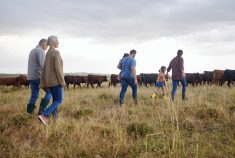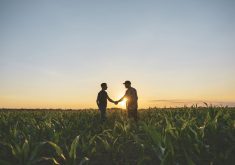A couple we’ll call Mike, 85, and Judy, 83, farm 1,200 acres in southern Manitoba not far from Brandon. Their farm has been reduced from its largest measurement, 2,500 acres. They have four sons. Two have their own farming operation of 2,000 acres each. A third son has a job off-farm. A fourth son we’ll call Bob is in his mid-50s. He is entirely dependent on Mike and Judy.
Mike and Judy consulted Don and Erik Forbes of Forbes Wealth Management in Carberry, Man., with the goal of providing for Bob after their demise. They say Bob has difficulties handling money. The goal is, therefore, to give him limited cash flow but not control of assets.
Read Also

Gentle treatments for pain in the neck
Heading toward year-end, people unknowingly tense up against the cold and busyness, causing neck pain that can often be treated with appropriate support and gentle mobility, athletic therapist Kathlyn Hossack says.
Mike and Judy can each use the $1-million personally owned farmland capital gains tax exemption plus exemption of the value of the primary farm residence and one acre. That might be worth $250,000. Thus, the first $2.25 million of farm capital gain could be exempt from federal tax, given that Manitoba tax is based on federal tax.
Mike and Judy can transfer land, equipment and inventory to their children at any value between book value and today’s market value, Don Forbes explains. They should try to use up all tax credits and tax exemptions for which they are eligible without claiming entire value of the farm, he advises.
The calculation is straightforward — the $7-million value of 1,200 acres of farmland less $459,000 book value. That leaves $6,541,000 capital gain. Take off $1 million each for Mike and Judy, assuming each qualifies for the $1-million exemption, and $4,541,000 is exposed to tax. Transfer of land before death would incur some Manitoba tax payable and trigger a clawback of some Old Age Security (OAS) benefits in the year of the transaction. The Alternative Minimum Tax (AMT) would add cost to the transfer. The AMT can be used up in the following seven years and is, thus, just a pre-payment of future tax.
The principal residence and acre of land would be tax-free on sale or transfer.
A matter of planning
Allocating land to the children is a matter of planning. A quarter can go to the non-farming son, a quarter to Bob and the remaining 5.5 quarters split between the farming sons held in trust for transfer to a future generation, Forbes explains.
The length of time for these transfers could be long. In order to protect land from any tort or other claims, a promissory note for transfer value, forgivable on the death of the parents, could carry interest equal to net rental income, says Forbes.
Through this process, assets would have a transfer price of current book value plus the $2.2-million tax exemption. The remaining taxable gain balance would be deferred to future owners through a lower deemed purchase price, that is, whatever the transfer value the parents decide.
In this process, two farming sons with all 7.5 quarters of land would pay rent to the non-farming children for the land they inherited. Mike and Judy should ensure that the $2-million tax credit is used first before other credit and deductions, Erik Forbes suggests.
For example, the transfer could be at a selected top-up rate of $1,666 per acre. The new owners of this legacy would have a transfer price of $2,048 per acre, that is $328 cost plus $1,720 adjustment to the market. The difference over cost would be a deferred capital gain liability.
Ensuring home and income for Bob is complex. He doesn’t file annual tax returns. However, as a person with low income, he would be able to receive quarterly GST cheques and a carbon tax rebate. If he is willing to apply for the disability tax credit, his unused personal tax credits can be transferred to his parents.
Bob could also apply for the Canada Pension Plan disability income. The disability certificate is essential.
The Province of Manitoba has an income support plan for people with disabilities. If he receives $100,000 in cash, the province would cut monthly support of, say, $2,000, until the $100,000 is used up. That would be 50 months, Don Forbes explains.
Bob could be beneficiary of a discretionary trust that gives him no right to expect or enforce payment of either income or capital. As a result, the capital inside the trust does not count toward the recipient’s asset limit. Only the income paid to a recipient is counted toward the income limits. Manitoba has a $500 per month exemption before deductions from monthly support levels calculated, Erik Forbes notes.
Other strategies
More can be done. Mike and Judy could establish a family trust. However, all investment income and disbursements would be taxed at the highest personal tax rates. Legal and accounting costs to set up and run the trust would be substantial. This plan can work, but its cost makes it the least attractive of planning strategies.
An informal family trust could be set up to provide non-taxable money for non-taxable money for Bob. Each of Mike and Judy could contribute $81,500 to their respective Tax-Free Savings Accounts (TFSAs). The TFSAs can have anyone as a beneficiary, so this would work for Bob. A son would also be a candidate as a successor trustee after the parents pass away or cannot continue to act as trustees for Bob.
Looking ahead, Mike and Judy can have $642 each OAS at 2022 rates, Canada Pension Plan (CPP) monthly benefits of $400 for Mike and $302 for Judy, net farm rent of $700 each and $70 per person investment income for a total $3,526. There could be TFSA cash flow as needed. The sum of various benefits and incomes excluding any farm rent income would be sufficient to cover $3,000 anticipated monthly living expenses, Forbes estimates.
There would be some inflation protection for OAS and CPP are indexed and farm capital and income can be assumed to grow over time. Ten years from now, if the partners are still of this world, and assuming a 2.1 per cent rate of inflation, their flow of increased income from the farm, now $36,000 but $41,637 in a decade, plus $21,927 other income, estimated $10,340 CPP and $19,999 from OAS and TFSA cash flow of $6,238 would total $100,141 before tax. Tax rates are not easy to predict, but we can be sure that Mike and Judy would have sufficient income to meet their relatively modest needs.















